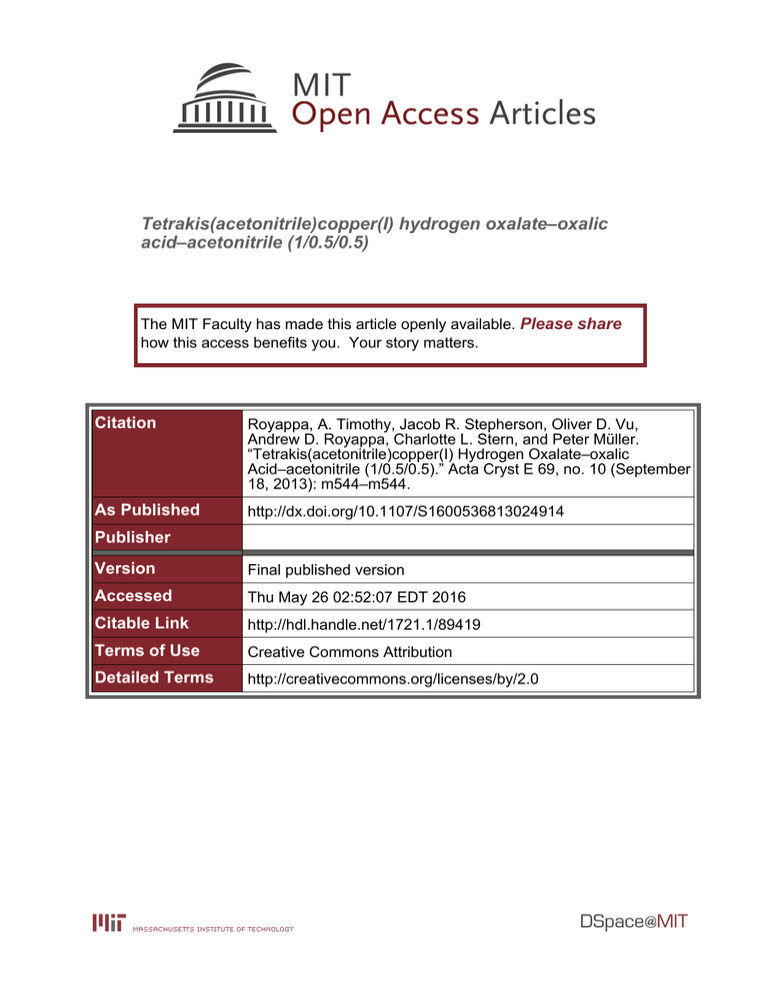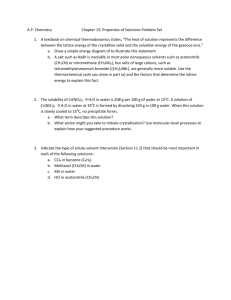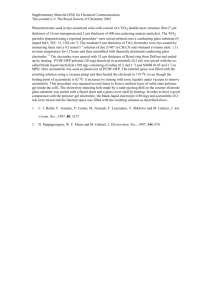Tetrakis(acetonitrile)copper(I) hydrogen oxalate–oxalic acid–acetonitrile (1/0.5/0.5) Please share
advertisement

Tetrakis(acetonitrile)copper(I) hydrogen oxalate–oxalic acid–acetonitrile (1/0.5/0.5) The MIT Faculty has made this article openly available. Please share how this access benefits you. Your story matters. Citation Royappa, A. Timothy, Jacob R. Stepherson, Oliver D. Vu, Andrew D. Royappa, Charlotte L. Stern, and Peter Müller. “Tetrakis(acetonitrile)copper(I) Hydrogen Oxalate–oxalic Acid–acetonitrile (1/0.5/0.5).” Acta Cryst E 69, no. 10 (September 18, 2013): m544–m544. As Published http://dx.doi.org/10.1107/S1600536813024914 Publisher Version Final published version Accessed Thu May 26 02:52:07 EDT 2016 Citable Link http://hdl.handle.net/1721.1/89419 Terms of Use Creative Commons Attribution Detailed Terms http://creativecommons.org/licenses/by/2.0 metal-organic compounds Acta Crystallographica Section E Experimental Structure Reports Online Crystal data ISSN 1600-5368 Tetrakis(acetonitrile)copper(I) hydrogen oxalate–oxalic acid–acetonitrile (1/0.5/0.5) A. Timothy Royappa,a* Jacob R. Stepherson,a Oliver D. Vu,a Andrew D. Royappa,a Charlotte L. Sternb and Peter Müllerc a Department of Chemistry, University of West Florida, 11000 University Parkway, Pensacola, FL 32514, USA, bDepartment of Chemistry, Northwestern University, 2145 Sheridan Road, Evanston, IL 60208, USA, and cDepartment of Chemistry, Massachusetts Institute of Technology, 77 Massachusetts Avenue, Cambridge, MA 02139, USA Correspondence e-mail: royappa@uwf.edu [Cu(C2H3N)4](C2HO4)0.5C2H2O40.5C2H3N Mr = 382.33 Monoclinic, P21 =n a = 9.5637 (4) Å b = 5.5670 (2) Å c = 32.0682 (12) Å = 92.901 (2) V = 1705.16 (11) Å3 Z=4 Cu K radiation = 2.15 mm1 T = 100 K 0.17 0.14 0.03 mm Data collection Bruker APEXII CCD diffractometer Absorption correction: multi-scan (SADABS; Bruker, 2007) Tmin = 0.715, Tmax = 0.938 8349 measured reflections 2928 independent reflections 2745 reflections with I > 2(I) Rint = 0.020 Refinement R[F 2 > 2(F 2)] = 0.036 wR(F 2) = 0.098 S = 1.12 2928 reflections 236 parameters 18 restraints H atoms treated by a mixture of independent and constrained refinement max = 0.89 e Å3 min = 0.50 e Å3 Received 3 September 2013; accepted 6 September 2013 Table 1 Key indicators: single-crystal X-ray study; T = 100 K; mean (C–C) = 0.004 Å; disorder in main residue; R factor = 0.036; wR factor = 0.098; data-to-parameter ratio = 12.4. In the title compound, [Cu(CH3CN)4](C2HO4)0.5C2H2O40.5CH3CN, the CuI ion is coordinated by the N atoms of four acetonitrile ligands in a slightly distorted tetrahedral environment. The oxalic acid molecule lies across an inversion center. The acetonitrile solvent molecule is disordered across an inversion center and was refined with half occupancy. In the crystal, the hydrogen oxalate anions and oxalic acid molecules are linked via O—H O hydrogen bonds, forming chains along [010]. Related literature For background to tetrakis(acetonitrile)copper(I) complexes, see: Morgan (1923); Heckel (1966); Kubas et al. (1979). For details of the affinity of nitrile ligands for CuI ions, see: Cotton et al. (1999). For the hard–soft acid–base theory, see: Pearson (1968). For the structure of the closely related tetrakis(acetonitrile)copper(I) tetrafluoroborate, see: Jones & Crespo (1998). m544 Royappa et al. Hydrogen-bond geometry (Å, ). D—H A D—H H A D A D—H A O1—H1 O4i O5—H5 O3 0.85 (2) 0.83 (2) 1.69 (2) 1.74 (2) 2.538 (2) 2.553 (2) 176 (3) 165 (4) Symmetry code: (i) x; y þ 1; z. Data collection: APEX2 (Bruker, 2007); cell refinement: SAINT (Bruker, 2007); data reduction: SAINT; program(s) used to solve structure: SHELXS97 (Sheldrick, 2008); program(s) used to refine structure: SHELXL97 (Sheldrick, 2008); molecular graphics: OLEX2 (Dolomanov et al., 2009); software used to prepare material for publication: CHEMDRAW (Cambridgesoft, 2003). ATR, JRS, ODV and ADR are grateful for support from the Office of Research and Sponsored Programs, the Office of Undergraduate Research and the Department of Chemistry at the University of West Florida. Supplementary data and figures for this paper are available from the IUCr electronic archives (Reference: LH5649). References Bruker (2007). APEX2, SAINT and SADABS. Bruker AXS Inc., Madison, Wisconsin, USA. Cambridgesoft (2003). CHEMDRAW. Cambridgesoft Corporation, Cambridge, MA, USA. Cotton, F. A., Wilkinson, G., Murillo, C. A. & Bochmann, M. (1999). Advanced Inorganic Chemistry, 6th ed., p. 856. New York: Wiley. Dolomanov, O. V., Bourhis, L. J., Gildea, R. J., Howard, J. A. K. & Puschmann, H. (2009). J. Appl. Cryst. 42, 339–341. Heckel, E. (1966). German Patent 1230025. Jones, P. G. & Crespo, O. (1998). Acta Cryst. C54, 18–20. Kubas, G. J., Monzyk, B. & Crumbliss, A. L. (1979). Inorg. Synth. 19, 90–92. Morgan, H. H. (1923). J. Chem. Soc. 123, 2901–2907. Pearson, R. G. (1968). J. Chem. Ed. 45, 581–587. Sheldrick, G. M. (2008). Acta Cryst. A64, 112–122. doi:10.1107/S1600536813024914 Acta Cryst. (2013). E69, m544 supplementary materials supplementary materials Acta Cryst. (2013). E69, m544 [doi:10.1107/S1600536813024914] Tetrakis(acetonitrile)copper(I) hydrogen oxalate–oxalic acid–acetonitrile (1/0.5/0.5) A. Timothy Royappa, Jacob R. Stepherson, Oliver D. Vu, Andrew D. Royappa, Charlotte L. Stern and Peter Müller 1. Comment The tetrakis(acetonitrile)copper(I) ion, an important starting material for the synthesis of copper(I) complexes, was first synthesized as the nitrate salt (Morgan, 1923). Commonly available and easily synthesized compounds containing the [Cu(CH3CN)4]+ cation generally do contain weakly coordinating anions such as BF4- (Heckel, 1966) or PF6- (Kubas et al., 1979). The structure of tetrakis(acetonitrile)copper(I) tetrafluoroborate already appears in the literature (Jones & Crespo, 1998). In this work, we report the synthesis and crystal structure of a compound containing the [Cu(CH3CN)4]+ cation containing a potentially coordinating HC2O4- anion, which does not coordinate to the metal center. This is in keeping with the known affinity of nitrile ligands for CuI (Cotton et al., 1999), and also with the hard-soft acid-base theory (Pearson, 1968), which predicts a weak interaction between the "hard" hydrogen oxalate ligand and the "soft" Cu+ ion. In the title compound, the [Cu(CH3CN)4]+ cation adopts a slightly distorted tetrahedral geometry. The HC2O4- anion is not coordinated to the CuI center and the distances of the nearest O atoms to the CuI ion are all greater than 4.7 Å. The anion is non-planar, whereas the oxalic acid molecules are strictly planar, and reside on inversion centers. All the OH groups (in the hydrogen oxalate anion and in oxalic acid) in this structure are involved in intermolecular hydrogen bonding interactions with the carboxylate O atoms of the hydrogen oxalate anion, forming one-dimensional chains along [010]. The acetonitrile solvent molecules present in the structure are disordered, and positioned in linear channels between the [Cu(CH3CN)4]+ cations, parallel to the b axis. 2. Experimental All manipulations were carried out under nitrogen. In a 10 ml round-bottom flask, 180 mg anhydrous oxalic acid (2 mmol), 0.143 g copper(I) oxide (1 mmol) and 7 ml degassed, dry acetonitrile were stirred together. All the red Cu2O powder dissolved in 2 min., forming a white precipitate and a clear, pale blue supernatant. After 15 min. of stirring, a copious amount of white and dark purple solids settled to the bottom of the flask. The dark purple solid was likely copper metal powder. This reaction mixture was stirred for 1 hr., then heated at 313K for 15 min., during which the white solid redissolved. Cooling to room temperature produced mm-sized, colorless, air- and moisture-sensitive, platelike crystals in 2 hrs. 3. Refinement H atoms were placed in calculated positions with C—H = 0.96 Å and included in the refinement in a riding-motion approximation with Uiso(H) = 1.5Ueq(C). H atoms bonded to O atoms were refined independently with Uiso(H) = 1.5Ueq(O). Acta Cryst. (2013). E69, m544 sup-1 supplementary materials Computing details Data collection: APEX2 (Bruker, 2007); cell refinement: SAINT (Bruker, 2007); data reduction: SAINT (Bruker, 2007); program(s) used to solve structure: SHELXS97 (Sheldrick, 2008); program(s) used to refine structure: SHELXL97 (Sheldrick, 2008); molecular graphics: OLEX2 (Dolomanov et al., 2009); software used to prepare material for publication: CHEMDRAW (Cambridgesoft, 2003). Figure 1 The molecular structure of the title compound with displacement ellipsoids shown at the 50% probability level. The symmetry complete oxalic acid molecule is shown and the acetonitrile solvent molecule is half occupancy. The dotted line indicates a hydrogen bond. Tetrakis(acetonitrile)copper(I) hydrogen oxalate–oxalic acid–acetonitrile (1/0.5/0.5) Crystal data [Cu(C2H3N)4](C2HO4)·0.5C2H2O4·0.5C2H3N Mr = 382.33 Monoclinic, P21/n Hall symbol: -P 2yn a = 9.5637 (4) Å b = 5.5670 (2) Å c = 32.0682 (12) Å β = 92.901 (2)° V = 1705.16 (11) Å3 Z=4 Acta Cryst. (2013). E69, m544 F(000) = 784 Dx = 1.489 Mg m−3 Melting point: not measured K Cu Kα radiation, λ = 1.54184 Å θ = 2.8–66.4° µ = 2.15 mm−1 T = 100 K Plate, colorless 0.17 × 0.14 × 0.03 mm sup-2 supplementary materials Data collection Bruker APEXII CCD diffractometer Radiation source: fine-focus sealed tube Graphite monochromator φ and ω scans Absorption correction: multi-scan (SADABS; Bruker, 2007) Tmin = 0.715, Tmax = 0.938 8349 measured reflections 2928 independent reflections 2745 reflections with I > 2σ(I) Rint = 0.020 θmax = 66.5°, θmin = 2.8° h = −11→11 k = −4→6 l = −37→36 Refinement Refinement on F2 Least-squares matrix: full R[F2 > 2σ(F2)] = 0.036 wR(F2) = 0.098 S = 1.12 2928 reflections 236 parameters 18 restraints Primary atom site location: structure-invariant direct methods Secondary atom site location: difference Fourier map Hydrogen site location: inferred from neighbouring sites H atoms treated by a mixture of independent and constrained refinement w = 1/[σ2(Fo2) + (0.0394P)2 + 2.6242P] where P = (Fo2 + 2Fc2)/3 (Δ/σ)max < 0.001 Δρmax = 0.89 e Å−3 Δρmin = −0.50 e Å−3 Special details Geometry. All e.s.d.'s (except the e.s.d. in the dihedral angle between two l.s. planes) are estimated using the full covariance matrix. The cell e.s.d.'s are taken into account individually in the estimation of e.s.d.'s in distances, angles and torsion angles; correlations between e.s.d.'s in cell parameters are only used when they are defined by crystal symmetry. An approximate (isotropic) treatment of cell e.s.d.'s is used for estimating e.s.d.'s involving l.s. planes. Refinement. Refinement of F2 against ALL reflections. The weighted R-factor wR and goodness of fit S are based on F2, conventional R-factors R are based on F, with F set to zero for negative F2. The threshold expression of F2 > σ(F2) is used only for calculating R-factors(gt) etc. and is not relevant to the choice of reflections for refinement. R-factors based on F2 are statistically about twice as large as those based on F, and R- factors based on ALL data will be even larger. Fractional atomic coordinates and isotropic or equivalent isotropic displacement parameters (Å2) Cu1 N1 C1 C2 H2A H2B H2C N2 C3 C4 H4A H4B H4C N3 C5 C6 x y z Uiso*/Ueq 0.00357 (4) 0.1201 (2) 0.1869 (3) 0.2716 (3) 0.3673 0.2735 0.2312 −0.1196 (2) −0.1829 (3) −0.2621 (3) −0.2024 −0.3433 −0.2941 0.1258 (2) 0.1743 (2) 0.2332 (3) 0.91194 (7) 0.6945 (4) 0.5512 (5) 0.3648 (5) 0.3724 0.3897 0.2070 1.1336 (4) 1.2842 (5) 1.4787 (5) 1.6211 1.5164 1.4297 1.1393 (4) 1.2988 (5) 1.5037 (5) 0.139464 (11) 0.10675 (7) 0.09207 (8) 0.07389 (8) 0.0863 0.0437 0.0794 0.10639 (7) 0.09054 (7) 0.07048 (8) 0.0689 0.0868 0.0422 0.17405 (7) 0.19157 (7) 0.21462 (8) 0.02214 (14) 0.0249 (5) 0.0223 (5) 0.0270 (6) 0.040* 0.040* 0.040* 0.0246 (5) 0.0221 (5) 0.0261 (6) 0.039* 0.039* 0.039* 0.0233 (5) 0.0197 (5) 0.0228 (5) Acta Cryst. (2013). E69, m544 Occ. (<1) sup-3 supplementary materials H6A H6B H6C N4 C7 C8 H8A H8B H8C C9 C10 O1 H1 O2 O3 O4 C11 O5 H5 O6 N1S C1S C2S H2S1 H2S2 H2S3 0.2187 0.3337 0.1868 −0.0979 (2) −0.1385 (3) −0.1875 (3) −0.1808 −0.2852 −0.1295 0.5095 (2) 0.5127 (2) 0.53399 (19) 0.533 (3) 0.48651 (18) 0.48900 (19) 0.53722 (18) 0.4732 (3) 0.5469 (2) 0.519 (3) 0.3702 (3) −0.002 (6) −0.0067 (6) 0.011 (3) 0.1114 −0.0304 −0.0347 1.6500 1.4783 1.5207 0.6916 (4) 0.5341 (5) 0.3283 (5) 0.1826 0.3540 0.3102 1.0524 (4) 0.7966 (4) 1.2210 (3) 1.355 (4) 1.0852 (3) 0.7711 (3) 0.6316 (3) 0.9454 (5) 1.0158 (3) 0.957 (6) 0.8228 (5) 0.4633 (17) 0.2602 (12) 0.016 (4) −0.0221 −0.0391 −0.0653 0.1979 0.2204 0.2410 0.17694 (7) 0.19555 (8) 0.21895 (8) 0.2020 0.2257 0.2448 0.17421 (7) 0.15534 (7) 0.14699 (5) 0.1595 (9) 0.21057 (5) 0.11715 (5) 0.18140 (5) 0.02028 (8) 0.05293 (5) 0.0747 (7) 0.02020 (6) 0.0000 (16) 0.00027 (18) −0.0032 (11) −0.0015 −0.0301 0.0195 0.034* 0.034* 0.034* 0.0236 (5) 0.0209 (5) 0.0227 (5) 0.034* 0.034* 0.034* 0.0159 (5) 0.0163 (5) 0.0218 (4) 0.033* 0.0203 (4) 0.0230 (4) 0.0203 (4) 0.0263 (6) 0.0268 (4) 0.040* 0.0575 (8) 0.0417 (18) 0.0306 (12) 0.042 (4) 0.064* 0.064* 0.064* 0.50 0.50 0.50 0.50 0.50 0.50 Atomic displacement parameters (Å2) Cu1 N1 C1 C2 N2 C3 C4 N3 C5 C6 N4 C7 C8 C9 C10 O1 O2 O3 O4 U11 U22 U33 U12 U13 U23 0.0241 (2) 0.0270 (11) 0.0234 (13) 0.0266 (14) 0.0261 (12) 0.0218 (12) 0.0273 (13) 0.0232 (11) 0.0174 (12) 0.0211 (12) 0.0238 (11) 0.0185 (12) 0.0242 (13) 0.0142 (11) 0.0131 (11) 0.0346 (10) 0.0265 (9) 0.0353 (10) 0.0279 (9) 0.0165 (2) 0.0223 (11) 0.0219 (13) 0.0234 (14) 0.0204 (11) 0.0233 (13) 0.0207 (13) 0.0201 (11) 0.0210 (13) 0.0204 (13) 0.0204 (11) 0.0203 (13) 0.0199 (13) 0.0134 (11) 0.0147 (12) 0.0102 (8) 0.0156 (8) 0.0144 (8) 0.0102 (8) 0.0258 (2) 0.0256 (11) 0.0215 (12) 0.0308 (14) 0.0271 (11) 0.0213 (12) 0.0305 (13) 0.0265 (11) 0.0207 (12) 0.0269 (13) 0.0267 (11) 0.0238 (12) 0.0241 (12) 0.0198 (12) 0.0215 (12) 0.0208 (8) 0.0190 (9) 0.0191 (9) 0.0227 (8) 0.00096 (15) −0.0008 (10) −0.0022 (11) 0.0039 (11) 0.0013 (10) −0.0020 (11) 0.0027 (11) 0.0000 (9) 0.0041 (11) 0.0009 (10) −0.0003 (9) 0.0022 (11) −0.0024 (11) 0.0006 (9) 0.0001 (9) −0.0010 (8) 0.0014 (7) −0.0016 (8) 0.0001 (7) 0.00143 (15) 0.0035 (9) −0.0010 (10) 0.0001 (11) −0.0002 (9) 0.0017 (10) 0.0019 (10) −0.0004 (9) 0.0020 (9) 0.0014 (10) 0.0023 (9) 0.0001 (9) 0.0012 (10) −0.0005 (9) 0.0027 (9) 0.0037 (7) 0.0030 (7) −0.0005 (7) 0.0002 (7) −0.00010 (15) −0.0003 (9) 0.0013 (11) −0.0054 (11) −0.0005 (9) −0.0042 (11) 0.0022 (11) 0.0006 (10) 0.0044 (11) −0.0028 (11) −0.0007 (10) −0.0048 (11) −0.0002 (10) 0.0016 (9) 0.0004 (10) 0.0004 (7) 0.0000 (7) −0.0009 (7) 0.0020 (7) Acta Cryst. (2013). E69, m544 sup-4 supplementary materials C11 O5 O6 N1S C1S C2S 0.0323 (15) 0.0361 (11) 0.0642 (16) 0.048 (3) 0.032 (3) 0.073 (8) 0.0246 (14) 0.0260 (10) 0.0815 (19) 0.033 (4) 0.036 (3) 0.026 (5) 0.0220 (13) 0.0184 (9) 0.0265 (11) 0.043 (2) 0.024 (2) 0.029 (8) −0.0025 (12) −0.0037 (8) −0.0442 (15) 0.009 (14) 0.001 (3) −0.019 (6) 0.0013 (11) 0.0004 (7) −0.0011 (10) −0.002 (2) −0.002 (2) 0.017 (7) 0.0012 (11) 0.0029 (8) 0.0054 (12) 0.001 (13) −0.003 (3) 0.007 (6) Geometric parameters (Å, º) Cu1—N2 Cu1—N1 Cu1—N4 Cu1—N3 N1—C1 C1—C2 C2—H2A C2—H2B C2—H2C N2—C3 C3—C4 C4—H4A C4—H4B C4—H4C N3—C5 C5—C6 C6—H6A C6—H6B C6—H6C N4—C7 1.977 (2) 1.981 (2) 2.002 (2) 2.017 (2) 1.139 (3) 1.456 (4) 0.9800 0.9800 0.9800 1.139 (3) 1.452 (4) 0.9800 0.9800 0.9800 1.137 (3) 1.457 (4) 0.9800 0.9800 0.9800 1.140 (3) C7—C8 C8—H8A C8—H8B C8—H8C C9—O2 C9—O1 C9—C10 C10—O3 C10—O4 O1—H1 C11—O6 C11—O5 C11—C11i O5—H5 N1S—C1S C1S—C2S C2S—H2S1 C2S—H2S2 C2S—H2S3 1.460 (4) 0.9800 0.9800 0.9800 1.211 (3) 1.311 (3) 1.548 (3) 1.242 (3) 1.256 (3) 0.849 (18) 1.198 (4) 1.293 (3) 1.547 (5) 0.829 (18) 1.132 (12) 1.38 (3) 0.9800 0.9800 0.9800 N2—Cu1—N1 N2—Cu1—N4 N1—Cu1—N4 N2—Cu1—N3 N1—Cu1—N3 N4—Cu1—N3 C1—N1—Cu1 N1—C1—C2 C1—C2—H2A C1—C2—H2B H2A—C2—H2B C1—C2—H2C H2A—C2—H2C H2B—C2—H2C C3—N2—Cu1 N2—C3—C4 C3—C4—H4A C3—C4—H4B H4A—C4—H4B C3—C4—H4C 115.66 (9) 114.26 (9) 104.25 (9) 102.50 (9) 110.40 (9) 109.84 (9) 171.6 (2) 178.9 (3) 109.5 109.5 109.5 109.5 109.5 109.5 171.1 (2) 179.2 (3) 109.5 109.5 109.5 109.5 H6A—C6—H6C H6B—C6—H6C C7—N4—Cu1 N4—C7—C8 C7—C8—H8A C7—C8—H8B H8A—C8—H8B C7—C8—H8C H8A—C8—H8C H8B—C8—H8C O2—C9—O1 O2—C9—C10 O1—C9—C10 O3—C10—O4 O3—C10—C9 O4—C10—C9 C9—O1—H1 O6—C11—O5 O6—C11—C11i O5—C11—C11i 109.5 109.5 166.9 (2) 178.4 (3) 109.5 109.5 109.5 109.5 109.5 109.5 125.5 (2) 121.6 (2) 112.99 (19) 126.2 (2) 119.0 (2) 114.79 (19) 108 (2) 126.1 (2) 122.0 (3) 111.8 (3) Acta Cryst. (2013). E69, m544 sup-5 supplementary materials H4A—C4—H4C H4B—C4—H4C C5—N3—Cu1 N3—C5—C6 C5—C6—H6A C5—C6—H6B H6A—C6—H6B C5—C6—H6C 109.5 109.5 166.5 (2) 178.5 (3) 109.5 109.5 109.5 109.5 C11—O5—H5 N1S—C1S—C2S C1S—C2S—H2S1 C1S—C2S—H2S2 H2S1—C2S—H2S2 C1S—C2S—H2S3 H2S1—C2S—H2S3 H2S2—C2S—H2S3 112 (2) 169 (3) 109.5 109.5 109.5 109.5 109.5 109.5 Symmetry code: (i) −x+1, −y+2, −z. Hydrogen-bond geometry (Å, º) D—H···A ii O1—H1···O4 O5—H5···O3 D—H H···A D···A D—H···A 0.85 (2) 0.83 (2) 1.69 (2) 1.74 (2) 2.538 (2) 2.553 (2) 176 (3) 165 (4) Symmetry code: (ii) x, y+1, z. Acta Cryst. (2013). E69, m544 sup-6






